The Road To Ramallah, Part Three
Whenever I visit a new city or country, one of the first things I find myself doing is to wonder whether I could see myself living there. It’s not as though I’m actively looking to move – though you never know – but it’s a way of getting a handle on a place, of trying to understand it in terms of what I already know, would like to know, or would like to think I know. I should also note that my standards for livability are, shall I put it, exacting. In my years of traveling, I’ve come up with only four or five places I found fully acceptable, and have already lived in most of them.
I started this process within an hour or two of arriving in Tel Aviv, and barely another hour or two had passed before I’d come up with an answer. It was an unhesitating, “Yes, but…”
I was surprised that “Yes” entered into it at all. Tel Aviv in particular and Israel in general suffered from several negative factors that usually rule out a place for me right away. For one thing, everybody smoked. Well, not everybody, but a larger percentage of the population than I’ve seen anywhere since the 1950s . Worse, they smoked almost anywhere they felt like it. As near as I could tell, there was some sort of prohibition on smoking indoors, but even when it was respected, it was often with only the most token of efforts. For example, a restaurant cook holding his cigarette out the window with one hand while preparing or serving food with the other.
Then there was the lack of a sensible or reliable public transit system. Oh, there were plenty of buses, and the ones I rode on were affordable and comfortable. But they were at the mercy of an automobile-based culture that often seemed to have turned the entire country into a giant traffic snarl. It was as though you’d transplanted Los Angeles attitudes – specifically the one where people would rather die than be seen walking or riding a bus – into the narrow, constricted streets of old New York or London, and while you were at it, done away with most traffic and parking laws.
What this meant in practice was that cars – and motorcycles, and a few intrepid bicyclists – went wherever they wanted or needed to. Since the streets were typically jammed to capacity, this included the sidewalks. I don’t know if the Hebrew or Arabic words for “sidewalk” contain any reference to walking; if so, they would be grievous misnomers. In modern Tel Aviv, with its somewhat wider streets, the parked cars usually leave enough space for a skinny pedestrian to squeeze by, but in the tortuous and constricted byways of East Jerusalem, most walking is done in the streets, weaving one’s way in and around the stalled and honking traffic.
In a way it’s a relief to see footpaths completely blocked by parked or idling vehicles, because when you do encounter a carless stretch of pavement, there’s a temptation to succumb to Western expectations, i.e., to suppose that only you and other pedestrians will be walking there. Relaxing your vigilance in this way can be perilous, as you’ll learn the first several times a motorcycle or car comes blithely careening at you. Getting out of the way is your problem, not theirs.
Curiously, one of the only places where there seemed to be respect for traffic laws was at crosswalks. Pedestrians would wait faithfully for the light to turn green even if there wasn’t a car in sight, the sort of thing that would strike New Yorkers and Londoners as both maddening and pointless. At first I did as I’ve always done and ignored the lights, but as the week went on, I grew increasingly self-conscious about pushing my way past the crowds who were doing as the signal instructed. Surely there must be some reason that this, of all laws, was the one they chose to obey.
Could it be that the police were militant about ticketing or arresting jaywalkers? I never saw it happen; in fact, it was seldom that I saw cops at all. Considering we were in the middle of a city with political and social stress lines running every way imaginable, policing was done in a surprisingly low-key manner. I don’t doubt it was there, but at a level that, while it might have been obvious to locals, mostly escaped my notice altogether.
That’s, of course, if you don’t count the machine-gun-toting soldiers one sees everywhere, but their function seemed something other than routine policing. I never saw a soldier do anything you’d expect a cop to do, like intervene in a dispute or tell someone to move his illegally parked car or pushcart. It felt like they were there mainly to send a message: that this area was under government control and that anyone posing a challenge to that control could count on being met with deadly force.
To be fair, I’d come to Israel during a period of relative tranquility. People who lived here had seen times when that was not the case, when bombs were going off and people were dying on a regular basis. And who’s to say it wouldn’t still be like that without the extraordinary security measures that, while not always visible, were clearly in effect?
Like the wall, for example. I could see it from my hotel, winding its way along the hills like an angry scar across the landscape. On one side, Palestine/the West Bank, on the other, Israel, but while that delineation might look perfectly neat and clearcut on a map, in real life, it divided – the Biblical term “rent asunder” might not be too strong – communities, villages, farms, highways, in as brutal a fashion as could be imagined. The Israelis argue that the wall, or “separation barrier,” was the only thing able to put a stop to terror attacks originating in the West Bank, and it’s true that since it was completed, such attacks have become infrequent.
But at what price, ask the Palestinians? Herded into enclaves that continue to dwindle as Jewish settlements encroach on what’s traditionally been seen as Palestinian territory, and cut off to a large extent from the economic activity that flourishes in Israel, many West Bank residents face an unpromising and uncertain future. It might not be too great a stretch to compare their plight to that of township residents during South Africa’s apartheid era.
And yes, just as in the South Africa of old, an enormous amount depends on your ethnic classification and the sort of pass that you hold. As a foreigner, I was privileged; I could go almost anywhere except a militarized zone or, apparently, the Al-Aqsa Mosque. But had I been a local , there would have been rigid restrictions on which cities I could live in or visit, which roads I could travel on, which checkpoints I could pass through, depending on whether my papers identified me as an Israeli Jew, an Israeli Arab, a non-Israeli Arab with an Israeli residence permit, or a Palestinian resident of the West Bank.
I never visited South Africa, but in 1987 I had the opportunity to spend a week in what was then known as West Berlin. I stayed in a fifth floor apartment abutting the River Spree, and looking out onto East Berlin. All week long I gravitated toward the windows that provided a panoramic view of the factories, shops and apartments of the GDR. Sometimes I’d see people staring back at us and would wave at them; occasionally they responded, but not usually. The real challenge was to get one of the guards who manned the machine gun nests lining the “death strip” to acknowledge us; nine times out of ten they would stare straight ahead as though we didn’t exist, but once in a while, a guard, usually after looking around to make sure he wasn’t being observed, would break character and give us a curt nod or a stifled wave of the hand.
I suppose it’s only human to become fixated on the one place where it’s difficult or impossible to go, even if, as was the case with East Berlin, many of the people who were there were devoutly wishing they could be anywhere else. The vast majority of my time in Berlin was spent within sight, often within touching distance of the Wall, and though West Berlin was replete with interesting places and people, I kept asking my hosts, “But when can we visit the East?” Which I was finally able to do on my last day there, and though my experiences on the other side were brief, not to mention slightly grim, depressing and even a little frightening, they stand out in my memory in a way that my more comfortable and relaxed time in West Berlin never could.
I should be careful when drawing parallels between the Berlin Wall and the Israeli Wall; one obvious difference is that while the Berlin Wall was meant to keep people in, the Israeli version aims at keeping them out. In that sense, it has more in common with the wall dividing the USA from Mexico, although, as one might expect, the Israeli version is far more efficient and effective. But in one sense it was exactly the same as any wall or barrier: as fascinating as I found Israel in general and Jerusalem in particular, my eyes and my thoughts kept straying over to the Other Side.
When I was planning my trip to Israel I’d been told in no uncertain terms that I “had to” visit the West Bank; one friend went so far as to say that not only was the West Bank much more interesting, but also that I’d be pretty much wasting my time if I failed to venture outside Israel proper. I thought that might be overstating the case, but I’d resolved nonetheless to at least make my way to Bethlehem.
“Fine, if you’re into the touristy stuff,” he sneered ever so slightly, “but you really need to go to Ramallah.”
I wasn’t proud to admit it, but while I’d been hearing Ramallah mentioned on news broadcasts for years, usually in connection with some violent outrage or other, I wasn’t too clear about its significance. I was only vaguely aware that it currently serves as the administrative capital of the Palestinian National Authority, and, I’m sorry to say, I’d become a little too much like most Americans, unable to get my head sufficiently around the Middle East conflict, and as a result tending to tune out most news that didn’t involve multiple fatalities or an impending apocalypse.
Much to my chagrin, I also have to acknowledge that until I started looking at maps in preparation for my trip, I didn’t even have that clear an idea of where the various cities and countries were situated in relation to each other, or of the erratic, seemingly capricious way the Green Line wound its way through the Israeli landscape, delineating what, depending on one’s sympathies, might be known as the Occupied Territories, the West Bank, the Palestinian homeland, or Greater Israel. Hard line Zionists, who have held the upper hand in Israel in recent years, barely try to disguise their intentions: the longer they can put off a peace agreement, the more they can honeycomb the West Bank with walled-off Israeli settlements and the more hopeless the process of turning it into a viable Palestinian state becomes.
Arguing with them is pointless: they have God and the Scriptures on their side, not to mention a powerful propaganda apparatus. A quick Google search will provide you with copious “evidence” that there is really no such thing as Palestine or Palestinians, that much of the land in question was only “sparsely settled” before Jewish immigrants began arriving en masse following World War I, and that of the millions of Arabs now resident in Israel and the West Bank, the majority were themselves recent arrivals, attracted by the jobs and improved living standards produced by the emerging Jewish state.
Not surprisingly, the Palestinians see it differently, and based on what I’ve seen, a number of conversations, and my own research, I’m more inclined to accept their point of view. They couldn’t all have made up stories about being chased or hounded out of their towns and villages, could they? And you can kind of tell when people have been around for a while, when they have a deep, organic connection to the land that’s not been manufactured by a political entity but can only come from living there, and being one of a succession of generations who have done likewise. Even in New York City, a town barely out of its infancy compared with Israel and Palestine, you don’t need rocket science to figure out who’s “from the neighborhood” and who’s a recent transplant.
Usually when I begin to learn about a given situation or problem, it doesn’t take long for me to start choosing sides, to start identifying bad guys and good guys, but that wasn’t working for me here. My general if not especially well-informed sympathy for Israel – the sort of ersatz feelgood patriotism that Americans have been inculcated with – was being tested and challenged, but had not totally evaporated. Despite becoming more aware of the misdeeds and injustices perpetrated in its name, I still liked the idea of Israel, still wanted it to succeed and prosper. I just didn’t want that success to come at the expense of millions of essentially innocent people who, as far as I could tell, had just as much right to be here as anyone else did.
Despite my best intentions, as the week wore on I found myself rebelling at the idea of traveling into the West Bank. I’d unhesitatingly braved the checkpoints to journey into East Berlin, and wandered blithely into the most militant Catholic and Protestant strongholds in Belfast and Derry when the Troubles were still in full sway, but, I rationalized, I was younger and more adventurous then. And despite the fact that I’d been greeted with courtesy and kindness by nearly every Arab I’d encountered, I was also an American who for years had been subjected to media images of bomb-throwing fanatics. Did I really need to put myself at risk, my cowardly side asked, just to personally see what I already imagined was the case: that things were not so great on the other side of the wall?
While conducting this inner debate, I continued to wander the Old City, traveled along its ramparts from the Jaffa Gate to the Lion’s Gate (finding out later that the State Department bans American diplomatic and military personnel from the eastern section of this trek because it is thought to be too dangerous), discovering an inordinate fondness for freshly squeezed pomegranate juice that I sipped in smoke-filled coffee shops under the bemused watch of old men nursing their hookahs.
To the north of the Old City walls, I explored the shops, markets and street life gravitating around Salah ad Din, namesake of Saladin, the 12th century sultan who evoked respect as well as fear in the European opponents he repeatedly thrashed on the battlefield. Today he might be branded a Islamic terrorist, but upon retaking Jerusalem from the Crusaders, he invited exiled Jews to resettle the city. Jerusalem’s more recent conquerors have tended to be somewhat less magnanimous.
Seeking a change of pace, I wandered up to Me’a She’arim, the militant Charedi enclave. Wall posters covered every available surface, their message delivered in strident, stentorian block letters devoid of color or illustration. I assumed – based purely on their stern mien – that the message was a religious one. Considering that they were rendered exclusively in Hebrew, I suppose they could just as easily have been saying “Shop at Jake’s,” but sometimes you can discern all you need to know from the tone, much as Oscar Wilde’s Algernon could instantly recognize the Wagnerian manner that only “relatives and creditors” could elicit from his doorbell. I later learned that these posters were called pashkvilim, and were indeed religious exhortations and denunciations, often complaining about shops that sold immodest “Manhattan”-style clothing or women who strolled the streets dressed “like harlots,” i.e., showing a bit too much wrist or ankle.
Hoping to observe a neighborhood that critics had decried as clinging resolutely to the 13th century, I found something more closely resembling the 1950s. If, that is, I’d spent the 1950s as the only goy in South Williamsburg (indulge me here, even though in the real life 1950s, South Williamsburg had not yet become as thoroughly Hasidic as it is today). Hasids are a subsect of the Charedim, and though I generally liked their sense of community and the way they’d taken care of the neighborhood, I’d had my run-ins with them, mostly involving bikes and bike lanes.
The Williamsburg Hasidim, for reasons that aren’t totally clear, have developed an aggressive antipathy toward bicycles. The official line is that they’re disturbed by scantily clad cyclists, especially of the female variety, who come riding through on Bedford Avenue, which doubles as an important cycling route and one of the principal thoroughfares of their community.
But I suspect there may be something more to it than that, since I, being neither female nor scantily clad, have had several unpleasant encounters on or around Bedford. Mostly they’ve involved someone simply refusing to see or acknowledge that I was there, and consequently driving, walking, or stopping directly in my path. At least twice I narrowly escaped crashing and/or sliding under the wheels of an oncoming truck when I had to take evasive action.
I realize how unfair it can be to judge an entire community or culture by the behavior of a few individuals, but it’s hard to avoid noticing that nowhere but in Hasidic Williamsburg did this sort of encounter happen on a routine, almost predictable basis. I thought about this when, as I strolled along the main drag of Me’a She’arim, a door suddenly opened and a bearded patriarch lumbered directly into my path.
I managed, by a matter of inches, to avoid colliding with him; rattled by the close encounter, I stammered, “Um, sorry, er, excuse me, er…”, realizing as I spoke that a) I did not know a word of Hebrew and had no idea how much if any English he understood; and b) that even though I was going out of my way to be polite and apologize, the near-collision had in no way been my fault. He hadn’t even tried to look where he was going. However, my years of living in England had produced in me the habit of saying “Sorry” as a response to any and all encounters, even if it’s to inform someone that he’s standing on my foot. And anyway, the gentleman carried himself, as Charedim and Hasids of a certain age and station tend to do, with such gravitas and authority that I actually did feel guilty about slightly impeding his progress.
I needn’t have bothered. He glanced at me, if that quick once-over flick of the eyes could even be dignified as a glance, with the interest and disdain one might reserve for a mildly unpleasant insect, and continued on his way. Which, again at the risk of generalizing or stereotyping, seems to be the attitude of the Charedim toward anyone, Jew or Gentile, who’s not fully signed up for a wholly theocratic Eretz Yisrael.
Let’s be fair, though: the Charedim are not exactly the only religious fanatics in the Holy Land. Just the most visible. Although none of the Muslims I met displayed any overt hostility, and while most spoke idealistically about peace and justice, somebody had to have thrown those stones and planted those bombs and launched those missiles. And while people can bemoan the stranglehold the Charedim have on certain aspects of Israeli politics and daily life, there are whole countries controlled by Islamic fundamentalists who are at least as extreme, if not more so, and for whom peace and justice are synonymous with the destruction of Israel as it’s presently constituted.
Such is not so much the case with some of Israel’s nearest neighbors, most notably Egypt, Jordan, and Palestine itself. There’s no shortage of anti-Israel sentiment, but for the most part it’s not a case of jihadis attempting to impose sharia law or restore the caliphate; it’s more about the wholesale loss of homes, land and freedom that has resulted from Israeli expansionism. This is not Saudi Arabia or Iran – nor even, for that matter, Gaza, where the ruling Hamas party is more overtly Islamist than President Mahmoud Abbas’ Fatah party, which, after a vicious and violent internecine struggle with Hamas, now controls the remainder of Palestine.
While most women wear modest head scarves, you’ll see more burqas and niqabs in West London than you will in the West Bank. The Muslim prohibition against alcohol is observed to the extent that you’re unlikely to see it being openly sold or consumed – except in Christian neighborhoods, of course – but neither is anyone being flogged in the streets for flouting that convention. While some premises – many cafes, for example – remain bastions of male privilege, women move about and socialize freely, drive cars, operate their own businesses, and generally comport themselves with an élan and alacrity seldom seen in the streets of Me’a She’arim. The current mayor of Ramallah, chosen by a predominantly Muslim electorate, is a Roman Catholic woman.
Only a few miles separate Jerusalem from Ramallah, and traveling there is deceptively simple: you mosey over to the Arab bus station situated just east of the Nablus Road, pay your six and a half shekels, and you’re on your way. It’s coming back that can be problematic.
Actually, maybe not quite that simple. For instance, I was using an Arab map, on which both the bus station and the Nablus Road were clearly marked. On many Israeli maps, the bus station, despite its hundreds of buses carrying thousands of passengers, doesn’t seem to exist. If it’s marked on the map at all, it’s designated as a parking lot. And the Nablus Road? No such road, apparently; on Israeli maps it’s been replaced by the Derech Shchem, Shchem being the Hebrew name for Nablus, one of the the West Bank’s principal cities.
The Arab buses are mostly 18-seaters – I’ve been on tours with bands using similarly sized vehicles, and while they ostensibly follow a schedule, the reality is that they leave when all the seats are filled. Fortunately that rarely takes long, in my case no more than five or ten minutes. Although I was the only gringo, er, Westerner, in sight, no one took any notice of me, and we were quickly rolling northward, the chatter of the passengers competing with the Arabic hiphop being blasted by the driver.
Maybe it was just my imagination, but it seemed as though the atmosphere grew quieter and more tense as we approached the border. For a while we rode alongside the separation wall, then entered a series of twists and turns and cutbacks that finally led us through the notorious Qalandia checkpoint, which shares its name with a nearby town and refugee camp. Vehicles leaving Israel aren’t stopped as a rule, though it can happen if the authorities feel like it. Our busload of Saturday shoppers and relative-visitors aroused no suspicions, however, and, somewhat more suddenly than I’d expected, we were through the barriers and into the West Bank proper.
I had expected things – very possibly dating back to my memories of the East-West Berlin divide – to look more dismal on the other side of the wall, and at first glance, they did. Trash littered the fields, a coating of dust seemed to cling to everything, and an air of poverty and discouragement hung like a pall over the first shops and homes I encountered.
But that would change as we drew closer to Ramallah. Many buildings were of makeshift and haphazard quality, but scattered among them was an impressive amount of new construction, some of it the equal of anything I’d seen in the more prosperous quarters of Jerusalem. In fact, viewed from its outskirts, Ramallah resembled something of a boom town, confirming stories I’d heard that portrayed it as one of the West Bank’s more notable success stories.
As we neared the center of town, Ramallah took on color and life out of all proportion to what I’d anticipated. As much as I’d tried to avoid expectations, I suppose I was guilty of presupposing a grim narrative of oppression and struggle, but regardless of whether people were downcast about the political situation, they were getting on with life in an exuberant and full-fledged manner. It couldn’t have hurt that we were on the eve of the festival of Eid al-Adha; the crowds in the streets were doing their holiday shopping and were in a holiday mood. Long before we arrived, traffic came to an almost complete standstill as pedestrians and pushcarts competed for space with cars, taxis and buses. Nearly all of the passengers disembarked, realizing that walking would get them there faster.
I was one of the last to get off, not because I had any desire to spend the rest of the day on a bus, but because I wanted to see where the bus station was so I’d know where to catch the bus back to Jerusalem. Staying on the bus until the end of the line seemed like the best way of accomplishing that, but I finally gave up on that plan, plunging into the crowds and cacophony and becoming completely lost within minutes.
Ramallah is not a big city, I kept telling myself, no more than 30,000 people. It’s impossible to really get lost if you stick close to the center. Impossible or not, I made a good stab at it, at one point wandering far up a hill that gave me a commanding view of the city but not of the bus station or anything else I was seeking. I decided I would follow the next bus back to the center of town, but this plan had a couple flaws: 1) all the buses continued to be stuck in traffic and were barely moving; and 2) not all buses, I eventually found, went to the same station. Then I couldn’t remember whether my bus had been white with green lettering or white with blue lettering, so I was no longer even sure what I was looking for. Only just arrived, I was already resigning myself to wandering the streets all night or hiring a private taxi to take me home. Not the best frame of mind for exploring a new town, so I told myself the hell with looking for the bus station, I’d find it later.
Which of course was when I realized I was standing in front of it, about 20 yards off Al-Manara Square. At that same moment, a passerby decided I must be in need of help and asked what I was looking for, leading to about 20 minutes of me trying to explain that while I’d been trying to find the bus station, I didn’t want to go anywhere now and him trying to puzzle out my itinerary and shepherd me into the appropriate bus or taxi.
Having finally persuaded him I’d be all right, I thought it was time to sample the local cuisine, starting with an aperitif of pomegranate juice at half the price it had been at even the cheapest stalls in the Old City. This tended to be the case with most prices, it was explained to me, which was why so many East Jerusalemites were willing to put up with the delays and aggravations of the checkpoints in order to do their shopping on this side of the border.
Next I found myself in a kebab shop up the street, a strange choice, given that it was not that radically different from one I could find anywhere in New York or London, but a good choice nonetheless, because it was there that I met the former Brooklynite – 28 years he’d spent there – who’d returned to his Palestinian homeland in one of the bursts of optimism that occasionally overtake the West Bank when there are tentative signs of progress in the seemingly never-ending peace talks with Israel. Since his arrival back in Ramallah, he’s seen bombings, riots, Israeli military incursions, not to mention near civil war between Fatah and Hamas; did he regret his decision, I wondered?
Not at all, he assured me. Ramallah was a wonderful place to live and work. “Much better than Brooklyn.”
The grainy black-and-white TV (it may have been a color model for all I know; the reception was so poor it was hard to tell) atop the cooler showed an amorphous mass of pilgrims winding their way toward the Kaaba in Mecca. “The Haj,” he told me. “Every good Muslim goes there at least once if he can.”
“Have you been?” I asked.
“Three times. It is wonderful. Difficult, but wonderful.”
“And dangerous? I’ve heard that sometimes people are crushed to death under the weight of the crowds.”
“Yes, this happens. Almost every year.”
I sat and talked with him for nearly an hour during which the TV kept its unblinking eye on the spiral-like procession; the several hundred thousand devotees began to resemble the individual cells of a single organism. I thought about Malcolm X’s account of his journey to Mecca and the personal epiphany he experienced there, felt the gears turning in the back of my own imagination. Perhaps I should undertake my own Haj? Would I have to become a Muslim to do so? I’m pretty sure the answer is yes, and similarly sure that this was but a momentary bit of kebab-fueled madness.
I spent another hour at a coffee house just off Al Manara, surrounded by sheesha-smoking men ranging in age from their early 20s to the late, late 70s, all of whom showed more interest in their hookahs and their card games than me or the blaring TV that flipped back and forth between two soccer matches, one from Germany, the other from Saudi Arabia. A heavily bearded fellow in olive green fatigues, the first person I’d seen all day – indeed, all week – who resembled a stereotypical terrorist, came in, looked around for an empty table, and, finding none, sat down at mine. With an almost imperceptible flick of the hand, he ordered a hookah that he smoked with quiet, intense purpose while studiously ignoring my existence.
By the time I resumed wandering the streets, it had been dark for a while, and the crowds of frenzied shoppers had dwindled down to a genial hubbub. I regretted not having made plans to spend the night in Ramallah, but told myself it was probably for the best. The following day I needed to make my way to Ben Gurion Airport for my journey home, and the airport was one of those places that, as the saying goes, you can’t get to from here. To travel anywhere in Israel from Ramallah, you first need to travel to Jerusalem. I’d been warned that the border checkpoints could be closed without notice at unpredictable intervals, and though it hadn’t happened lately, it would be just my luck for it to happen just when I had a plane to catch on the other side of the country.
So around 11 pm I boarded a bus for Al Quds (the Arabic name for Jerusalem). With the previously clogged roads now almost empty of traffic, the trip to the Qalandia checkpoint took a fraction of the time it had coming the other direction. I was surrounded by a group of rowdy young men in their late teens or early 20s; they had that way, common to young men everywhere, of talking and laughing twice as loud as necessary, and I sighed inwardly, hoping that they wouldn’t notice me or feel the need to involve me in their boisterous interchanges.
I was struggling with the curtain that covered my window (nearly all buses are curtained as protection against the desert sun). I wanted to get a last look at the lights and sights of the West Bank, but I couldn’t seem to get the curtain to stay more than halfway open. Suddenly, with a great swooshing sound, it slid all the way to the back and a gale of laughter erupted from the young men. “Is better?” said the one seated directly behind me, and they all laughed again.
His name was Jamal (“Like your American basketball player”). He spoke English quite well, though most of his friends had only a passing acquaintance with it. They were friendly nonetheless, and their rowdiness vanished instantly, replaced by a quiet eagerness to communicate about all sorts of things. “Tony Blair, do you know his sister is Muslim?” one of them delightedly informed me, and it only slightly dampened his enthusiasm when I explained that it was actually his wife’s sister, Lauren Booth, who had converted to Islam.
Did they live in Ramallah or in Jerusalem, I asked Jamal, wondering if the lads were headed for a night on the town or coming back from a day of shopping. “I live in refugee camp,” he said, and must have seen my face fall, because he quickly added, “It’s not so bad. You can come there and look.”
I asked him how long he’d lived there. “Always. I am born there. My father and grandfather had land, but when the Jews came, they had to leave and go to the camp.”
“You mean they just kicked them off their land and out of their house?” I asked.
“Yes, the soldiers come and everyone has to go. If you don’t, they shoot you. What can you do?”
“What can you do?” turned out to be Jamal’s mantra, invoked every time some particular aspect of Israeli injustice came up. I couldn’t help thinking he was awfully serene about things that, were they happening to me on a routine basis, would have my blood boiling.
The checkpoint loomed ahead of us. I’d deliberately waited to start my trip back because I’d heard that in late afternoon and early evening the crowds of returning shoppers could create bottlenecks that lasted hours. My strategy seemed to have worked, because ahead of us I saw only a handful of pedestrians waiting. The bus came to a halt and everybody began piling off.
I was unsure what I was supposed to do. People had told me that as a foreigner, I didn’t need to go through the crossing on foot as the Palestinian passengers did. “Just stay on the bus,” I’d been advised. If I were to do so, however, I’d have been on my own; just as on my trip out earlier in the day, I was the only non-Arab present. In fact, during my entire visit to Ramallah the only obvious foreigners I’d seen besides myself were an elderly German couple bewilderedly clutching a guidebook.
At any rate, even if my American passport did grant me special privileges, I didn’t feel like exploiting them. I wanted to experience for myself what the Palestinians had to go through, so I tagged along with Jamal and his friends, who assured me that they’d show me what to do. The first thing you see as you approach is a series of chutes made up of steel bars, the sort of thing you’d expect to find in a slaughterhouse through which cattle are led to their date with the executioner. Being a bit claustrophobic, I was thankful that at this hour the chutes were mostly empty; apparently at busier times of the day, people can spend an hour or more trapped inside them, with barely enough room to turn around, let alone scratch an itchy back or pick up something they might have dropped.
At the end of the chutes there’s a small space, strewn with trash and mostly open to the elements, which must make it quite miserable during the winter. There we waited to be allowed, two or three at a time, through a turnstile that leads into the next chamber, where, behind a pane of bullet and bomb-proof glass, an Israeli border guard waited to examine our papers.
The turnstile is similar to those used as entrances and exits in some New York City subway stations, with one difference: it’s controlled by the border guard, who can and does lock it whenever he or she decides that enough people have come through. Anyone who happens to be transiting the turnstile at that moment is trapped inside of it for however long the border guard sees fit to keep him there. In practice this could mean anything from a minute or three to, well, however long it takes. My claustrophobia flared up again as Jamal, who was directly in front of me, was caught in exactly this predicament. He shrugged and grinned, and then, when after four or five minutes, still hadn’t been released, hurled a few random curses at the guards, most of whom know little or no Arabic.
A metallic clank signaled that the turnstile had been unlocked, allowing Jamal to move forward and meaning it was now my turn. I pushed through as quickly as possible in hopes that I could avoid being trapped as Jamal had been, and I must have had beginner’s luck, because I made it in one go. Now I had to stand several feet back while Jamal held his ID card up to the window for the guard to examine, and, once he’d been cleared, wait for the guard’s disembodied voice to summon me forward.
But first I had to put my belongings onto a conveyor belt to be x-rayed, and had a sudden moment of panic when I realized that my cell phone, camera, and other valuables were sitting in the next room, completely unguarded. What if Jamal’s friendliness had been a ruse; he could have grabbed my things and disappeared into the night and I, still waiting to be examined, wouldn’t be able to do a thing about it. My anxiety increased when the young woman behind the glass took forever to study my passport and visa, and with a series of random gestures indicated that I wasn’t holding them up correctly.
She’d raised her eyebrows at the sight of my American passport, and, without ever saying a word to me, kept me there for about five minutes while she looked up something on the computer, then made a couple of phone calls. Was I going to be accused of being a subversive? Branded as a terrorist sympathizer? Finally, with an ever-so-slight jerk of the head, she indicated I was free to go; I pushed my way through another turnstile and was back on Israeli soil. Jamal – and my belongings – were waiting for me.
All that remained then was to wait for our bus to re-appear, which took about half an hour. Added to the time we’d spent going through chutes and turnstiles, this meant the whole experience had taken about an hour, on a night when the checkpoint was virtually deserted. The rest of the trip into Jerusalem was uneventful. Jamal and his friends got off at the interchange leading to the Shuafat Refugee Camp, and the other passengers disembarked at regular intervals. By the time we reached the Damascus Gate, only three or four of us remained.
The following morning, while waiting for the sherut (a sort of shared taxi/shuttle bus) to take me to the airport, I talked with Samir about Ramallah, where, as it happened, several members of his family lived. The previous day, in fact, Samir’s cousin had volunteered to drop me there on his way home; the only thing that stopped me from enthusiastically taking him up on his offer was that he wouldn’t be leaving until too late in the day.
I wished I’d arranged my trip so that I could have spent more time on the West Bank; if I had it to do over, I’d probably take at least two weeks rather than one, and spend half that time in Ramallah and other Palestinian cities. If nothing else, the whole experience had reawakened in me a sense of adventure and inquiry that had been missing from my travels in recent years. For too long my principal criteria in choosing a destination had involved such things as the ready availability of decaf cappuccinos and reliable wi-fi access; now I was drawing up itineraries spanning much of the Third World.
To be perfectly honest, while a trip to Ramallah might seem exotic and even a little dangerous to untraveled Americans in thrall to the media image of the Middle East, there are parts of Brooklyn and Queens that would be riskier to visit, and don’t even get me started on the Bronx. Even before I was through congratulating myself for having ventured outside my comfort zone, I was being told that “Ramallah is not Palestine,” not the real Palestine, anyway. It’s too rich, too modern, too comfortable, more than one commentator suggested.
It’s an interesting question: is Ramallah the Israeli version of a Potemkin village, allowed to flourish just enough so that visiting Westerners can be convinced that those Palestinians don’t have it so hard after all? Or is it, as the optimists might prefer to think, a showcase for what a free Palestine might eventually look like?
It’s a long way from here to there, in any event. Until the Israelis stop allowing militant Zionist settlers to chip away at what’s left of the putative Palestinian homeland, until the casual dehumanization and abuse of the walls and checkpoints and camps is brought to an end, until Jerusalem becomes an international city that is the property of all faiths and cultures rather than the bitterly contested capital of one side or the other, I don’t see much hope for peace in the Holy Land. If I were in charge (fat chance, of course), I’d start by telling the Israelis to move their capital to Tel Aviv and the Palestinians to keep theirs at Ramallah. Jerusalem itself would be completely depoliticized, and no longer the plaything or battlefield of militant Zionists or Islamists.
As I say, a long way from here to there. In any number of market stalls, you can buy t-shirts that, in a clever parody of the American rock band, proclaim “Guns’n’Moses.” It’s a clever, seductive concept, one that had me momentarily wondering whether I should buy one as a souvenir until I realized with a jolt how unfunny the notion of combining weapons with religious fanaticism really is. It’s about as cute as giving suicide bomber dolls to your kids. If I’d learned anything from my time in Israel and the West Bank, it was the overwhelming majority of people don’t want to be held hostage by the extremists, and yet they continue to be.
The ancient lands that comprise Israel and Palestine are immersed in and suffused with history, history that, as Stephen Dedalus would put it, is a nightmare from which they are trying to awake. And yet awake they must. It’s tempting to say that they will continue to muddle through one way or another, that, after 10,000 years of contending tribes, conquests, invasions, rapes and pillages, it’s utterly vainglorious of us to think that anything we might say or do in our meager life spans could be of great significance in the overall scheme of things. Civilizations come and go, rise and fall, goes this reasoning, and in some form will outlive us all.
Perhaps. But the Roman legions, the Islamic cavalry, the Crusaders, the Ottomans, none of these conquering hordes possessed the power to completely obliterate the land and its people, and possibly drag down the rest of the world in the process. Today there are people on both – on several – sides of the struggle who do possess that power, and some who might be willing, even eager to use it. While to most of us Armageddon represents the sum of all fears, there are those to whom it is a fate to be rapturously welcomed, and not all such people live in the Middle East; some of them hold positions of great power and influence right here in the United States.
The clock may be ticking, but there’s still hope, and as long as there is, I would urge my fellow Americans – my fellow Westerners, really – to learn more about this struggle, to investigate for themselves rather than passively consume the simplistic messages they’ve been fed by the media and their political leaders. One very brief visit to the Middle East has hardly made me an expert; if anything, it’s succeeded in making me aware of how little I actually know. But awareness of ignorance is a better starting point than ignorance of ignorance, so perhaps I’ve made at least a little progress.
Israel – and this includes Palestine as well – is a beautiful and vibrant land. You’d be crazy not to visit it if you have the chance, and equally crazy if you pass up the opportunity to go beyond the normal tourist sights and see how the other half lives. It’s not that hard, it’s not that dangerous – hell, you can even walk between Ramallah and Jerusalem like this guy did, the distance is so short. So short, and yet a lifetime and a life and death struggle apart for those who can not or will not see.

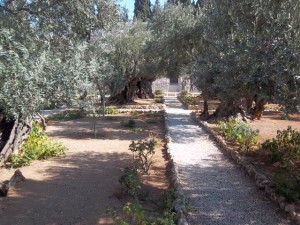
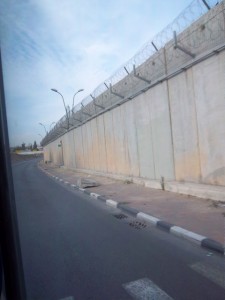

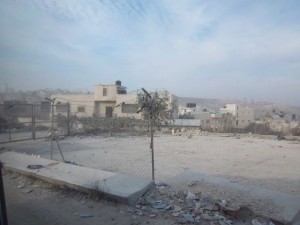
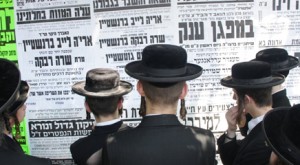
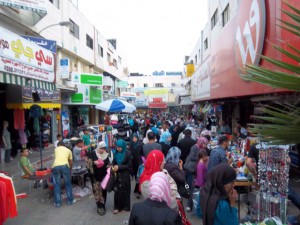
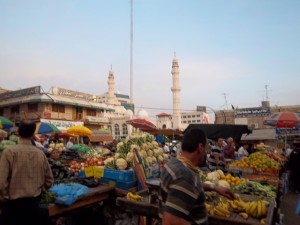

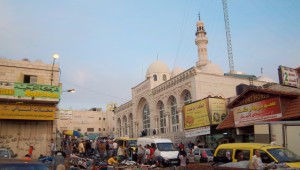
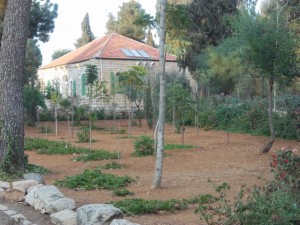
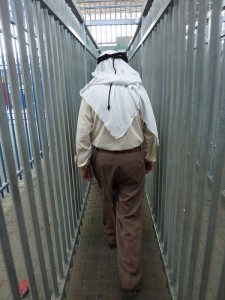
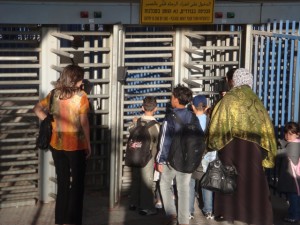
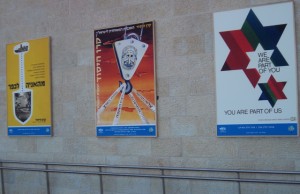
Finally read all three parts to your thougtful and well-written travelblog to Israel. I particularly appreciated the perspective on travelling back into Israel via the Qalandia checkpoint.
I too always see a new city wondering if I could live there. Perhaps it is just trying to jam a new city into the framework of what we know. Tel Aviv was a surprisingly awesome city to me as well.
Wanderlust rocks. Like you said, go beyond decaf cappuccinos. Seeing other peoples realities is fucking mindblowing.
Abbey – Ditto.
Larry – This is good enough to be in Time, Newsweek, a book, something beyond this blog. Thanks for sharing.